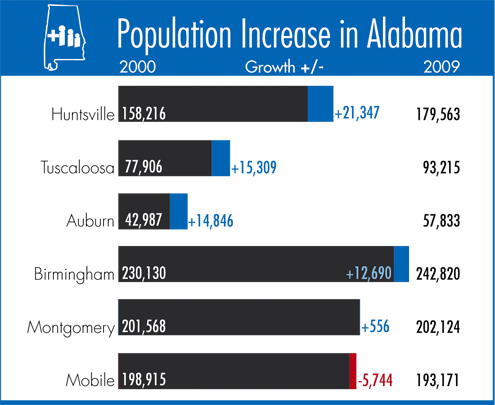In the past 10 years, Tuscaloosa added more people to its population than every other city in Alabama except Huntsville, according to the U.S. Census Bureau. In July 2009, the city of Tuscaloosa had a population of 93,215, which represented 49 percent of Tuscaloosa County’s inhabitants, the Census Bureau also said. The University of Alabama plays a role in this population by adding 28,807 tax-paying students.
Tuscaloosa City Clerk Tracy Croom, who has lived in the city for 20 years, said the city’s relationship with the University is one of mutual benefit.
“The relationship between the University and the city of Tuscaloosa is an incredible give-and-take type,” she said. “Students here on campus pay taxes, and [UAPD] works on game days. Neither is more important, but both play a huge role within each other.”
The University’s 2000 enrollment was 19,307, according to the UA Registrar, which means there has been almost a 7 percent increase in student enrollment from 2000-2010. There are several factors that have contributed to this, including the arrival of President Robert Witt, who implemented changes in the University’s recruiting strategies.
Witt’s Strategic Plan 2000-2014, which may be viewed at www.strategicplan.ua.edu, defines how enrollment will continues to increase over the next 10 years.
“Enrollment growth will be possible by attracting additional students from surrounding states who seek a high quality education, and through the growth of high-quality distance education courses that attract serious students from around the world,” the Strategic Plan states.
Melissa Skelley, a sophomore majoring in business, said she thinks admissions is doing a great job recruiting new students.
“There are so many students here from all over the world, and I think admissions deserves credit for it,” she said. “They are sending great recruiters all over the country to inform them about the University and bring them here.”
Mary Spiegel, executive director of undergraduate admissions, said the enrollment process has been more aggressive and persistent since Witt’s arrival.
“The University’s recruiting efforts over the last few years have been very effective in encouraging more students to apply,” she said. “Since Dr. Witt arrived on campus in 2003, the total number of applications received has grown from 8,129 for fall 2003 to 19,500 applications for the entering class of 2009.”
Jessica Pitts, a senior majoring in mathematics, thinks the University has a much larger influence on the city than the city does on the University.
“I think [the relationship] is more one-sided,” she said. “The University expands, which causes the city to expand as well. Also, the more students there are, the more buildings are needed to accommodate these students, and that continually expands this campus. I think that students alone are bringing in a lot of money to the city that couldn’t have been generated without this University.”
Croom said the city and the University have a great working relationship.
“We have more than 1,200 employees in the city and 17 departments, and some of these include students,” she said. “We offer work-study positions within the city and our departments. So neither of these can work without the other.”
Tuscaloosa’s population was approximately 77,206 in 2000, and by 2008, population had grown to approximately 90, 261, according to the Census Bureau. The 2010 census is still being calculated, but Croom said the city is hoping for at least 100,000 inhabitants in order to help the city continue to prosper.







